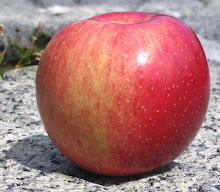I may have been a bit hard on Red Delicious earlier.
I've never hidden my tastes, and there are more than a few apples that don't thrill me. But my actual feeling is, the more varieties the better, whether or not they are my personal favorites.
In that respect, the story of Red Delicious is a cautionary tale.
Since its discovery more than a century ago, Red Delicious (originally "Hawkeye") has been mercilessly tweaked by breeders, growers, and market forces to produce the elongated bright red fruit we know today.
These are beautiful, indestructible, shippable, commercial, and tasteless. And, we love them. Or did.
By 1980 Red Delicious comprised three quarters of the apple harvest in Washington State's Apple Basket, the growing region east of the Cascade Mountains.
But apparently my own childhood preference for this fruit, and subsequent disillusionment, mirrored America's. The public turned away from this variety, and the apple industry crashed badly.
From the New York Times in 1990:
"Nobody should feel sorry for us—we did this to ourselves," said Doyle Fleming, a lifelong apple farmer who has been gradually replacing his Red Delicious trees near this village along the Columbia River with newer varieties.
"For almost 50 years, we've been cramming down the consumer's throat a red apple with ever thicker skin, sometimes mushy, sometimes very good if done right, but a product that was bred for color and size and not for taste."
Red Delicious had become an economic monoculture. Just as Baldwin, once the Northeast's preeminent apple, succumbed to an especially harsh winter (to be replaced by McIntosh in the hearts and mouths of the public), Red Delicious was felled by market forces.
Since apple trees don't grow overnight, it took the industry a decade to recover.
If there is a moral to the story, it is for growers to let a thousand blossoms bloom and refrain from putting all their apples in one basket.
Successful orchards diversify; they grow a mix of what's trendy and what's tried-and-true. (See, for instance, what they grow at Shelburne Farm.)
The Washington Post, in a news story that is required reading on this topic, describes the original Hawkeye as "a round, blushed yellow fruit of surpassing sweetness." There's a mouth-watering picture of this heirloom at Grist.
Wouldn't you love to try one of those heirloom Hawkeyes?
Update: Years later, I did!


That is a gorgeous apple, the one at Grist! I can't help wondering what that tasted like. I don't think you were being too hard on the current Red Delicious. I haven't enjoyed them when I've had them in the past few years. They tend either to be mealy and/or they lack flavor. At the moment I'm eating a Pacific Rose. It's a little disappointing. The flesh is sweet and crisp but the peel seems bitter and doesn't combine well with the flesh. But it's better than eating a mealy Red Delicious.
ReplyDeleteNina
A mealy Red Delicious would be truly pointless.
ReplyDeleteThis variety grows here in New England, and might be best off the tree. But none of those local apples make it into storage for the the wholesale market. Most people enjoy their Red Ds (or don't as the case may be) from supermarkets.
Maybe I'll try a local one in the fall, just to see if there is any more there there. My review apple, trucked on from Washington to my supermarket (shellac and all), is representative of what most Red Delicious fans eat.
I think it was mealy Red Delicious which made me think that I didn't really like apples as a fruit. Thankfully this has been remedied my recent brain explosions via the taste of my home grown apples from heritage varieties... now here I am investigating your back catalogue of interesting blogs
ReplyDeleteKeep up the good work
Matty B
Matty, welcome to the amazing world of apples. Better late than never!
ReplyDelete